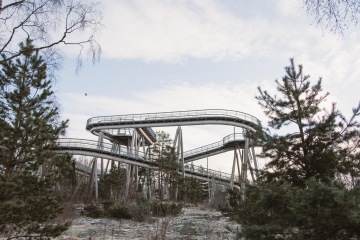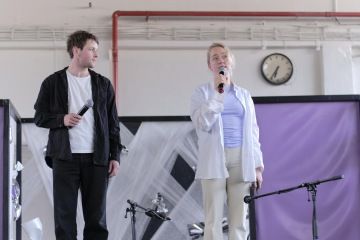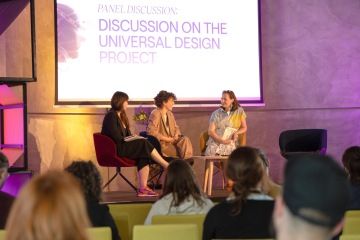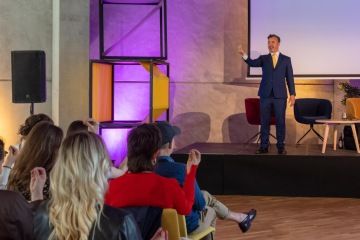Stovnertårnet – closer to nature
Stovnertårnet is a spectacular 260-metre walking path and lookout tower that extends 15 metres above the ground with beautiful views of Oslo. It is also a sanctuary, a meeting place and an urban nature attraction built on universal design principles to ensure inclusion of a diversity of visitors.
Commissioning party: Agency for the Urban Environment in Oslo
Design: Link Arkitektur AS, Link Landskap
Partners: Stovner district, ÅF Lighting (lighting design), Multiconsult (RIB), Consto AS (general contractor), Degree of Freedom, Municipal Undertaking for Social Service Buildings (Omsorgsbygg).

Vyhlídková věž v městské části Osla je inspirovaná letem místních ptáků. Tento pohyb se otiskl do tvaru věže. Jednotlivé vyhlídky odkazují na hnízda, které si ptáci tvoří v korunách stromů. Foto: Jitka Smolíková
Challenge
Stovnertårnet (The Stovner Tower) is part of an area improvement plan for Stovner, a borough located to the far northeast of the city of Oslo that has experienced major urban challenges. The aim was to provide the district with an attraction that is so appealing that it becomes a destination for both locals and visitors and inspires outdoor activity and recreation.
The location is one of Oslo’s best, uniquely overlooking the capitol and surrounding landscape. The main idea behind the tower was to create something that would allow everyone to experience views of the entire city, proximity to nature and the local historical context.
The Agency for the Urban Environment in Oslo came up with building a universally designed tower. The landscape architects were given free rein to interpret the concept with one important requirement; that it must provide an experience that everyone can enjoy.
Lead users: Local residents, youth groups, pensioner associations and other interest groups
Methods: Interviews, consulting, user testing
Awards: Category winner for Landscape Architecture, Innovation Award for Universal Design 2020
Methods and users
A user participation process examining the tower's possibilities was carried out with youth groups, pensioner associations and other interest groups via the district administration office. This process included an invitation to an open public meeting that presented proposals in 3D animation. A stand was also a set up at the local shopping centre, where everyone could submit ideas. This generated support for the project in the local community by encouraging people to get involved.
The assignment and insights obtained gave the landscape architects the possibility of a creative process with grand visions, albeit with a tight budget. They aimed to let the specific location be the leading premise to create a dizzying, circular space on a hill with traces of ancient times and open up the airspace in a way that would eliminate all barriers.
A user participation process examining the tower's possibilities was carried out with youth groups, pensioner associations and other interest groups via the district administration office. This process included an invitation to an open public meeting that presented proposals in 3D animation. A stand was also a set up at the local shopping centre, where everyone could submit ideas. This generated support for the project in the local community by encouraging people to get involved.
The assignment and insights obtained gave the landscape architects the possibility of a creative process with grand visions, albeit with a tight budget. They aimed to let the specific location be the leading premise to create a dizzying, circular space on a hill with traces of ancient times and open up the airspace in a way that would eliminate all barriers.
"I could easily say the Opera, but choose Stovnertårnet, as Oslo's most beautiful building. The building means that the user experiences the city in a new way."
Ellen de Vibe, Architect and retired director of the Planning and Building Agency in Oslo
Insights
Universal design has been the primary focus to make the tower accessible to everyone, regardless of their ability level, activity level or local affiliation. The project is also an example of a successful collaboration between several municipal departments in Oslo, landscape architects and solution-oriented contractors, who have all worked towards the same goal.
Results
Stovnertårnet is designed as a circular path with a gradual ascent extending 15 metres above the ground and 215 meters above sea level. The design is inspired by birds taking flight into the sky. As the pathway ascends, landings serve as rest stops where several visitors can sit together, relax and enjoy the view. The plateaus are furnished with adapted leaning, lying and sitting elements, and the design's playfulness brings bird nests to mind.
The path is wide enough for two people to walk alongside each other and to allow two prams or wheelchairs to pass one another, to promote safety and socialising. The railing has a height of 1.3 metres and, together with a slight inward incline, offers a sense of safety, as well as genuine security. The lighting in the tower emphasises the circular movement and contributes to the neighbourhood being perceived as safe and accessible both day and night.
As part of the experience, a communication project was established in collaboration with the city's cultural heritage office to promote learning about the area's local history and development of Oslo from the Ice Age to the present day. Laminated wooden plaques were used representing branches or tree structures that have been placed in the terrain as discreetly as possible.
The choice of materials and design was carefully chosen, and it was also important to consider the space under the tower to prevent an underside or 'non-side'. The tower itself is constructed of unique modules and is scalable.
The tower has become a major social arena, where everything from uphill running and dating, contemplative meditation, exercise, training to outings and celebrations take place, regardless of age or ability level. It is also used by many who would not normally be inclined to experience nature. The tower's popularity extends beyond the neighbourhood borders, which has also boosted the pride and sense of the Stovner residents' identity.
The case study was published with the permission of DOGA. Explore more case studies on DOGA website.
Articles
We are unsure if true inclusive design can exist in the systems we operate in today, say curators of Design for All exhibition
The interview with curators of Design for All exhibition Thea Urdal and Herman Billet on universal design, creating meaningful connections and building communities.
Design for All in pictures - Key activities of the project
Most of the activities of Design for All project culminated in May as part of 9th Zlin Design Week. Look back and remind the key activities such conference, exhibition and edu workshops through videos and pictures.
Recording from Zlin Design Week Conference is available
The Zlin Design Week Conference took place on 9 May 2023 in Zlin, Czech Republic and through lectures and joint discussions offered various perspectives on the topic of Universal Design. Watch the full conference recording or just select the talks you are interested.



